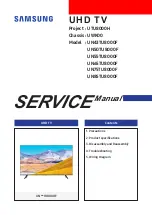
Service Modes, Error Codes, and Fault Finding
EN 32
Q528.1E LA
5.
right, new errors are logged at the left side, and all other errors
shift one position to the right.
When an error occurs, it is added to the list of errors, provided
the list is not full. When an error occurs and the error buffer is
full, then the new error is not added, and the error buffer stays
intact (history is maintained).
To prevent that an occasional error stays in the list forever, the
error is removed from the list after more than 50 hrs. of
operation.
When multiple errors occur (errors occurred within a short time
span), there is a high probability that there is some relation
between them.
Basically there are three kinds of errors:
•
Errors detected by the
S
tand-by software.
These errors
will always lead to protection and an automatic start of the
blinking LED for the concerned error (see paragraph “The
Blinking LED Procedure”). In these cases SDM can be
used to start up (see chapter “Stepwise Start-up”). Note
that it can take up to 90 seconds before the TV goes to
protection and starts blinking the error (e.g. error 53)
•
Errors detected by main software that lead to
protection.
In this case the TV will go to protection and the
front LED should also blink the concerned error. See also
paragraph “Error Codes” -> “Error Buffer” -> “Extra Info”.
For this chassis only error 63 is a protection error detected
by main software.
•
Errors detected by main software that do not lead to
protection.
In this case the error will be logged into the
error buffer and can be read out via ComPair, via blinking
LED method, or in case you have picture, via SAM.
5.5.2
How to Read the Error Buffer
Use one of the following methods:
•
On screen via the SAM (only if you have a picture). E.g.:
–
00 00 00 00 00
: No errors detected
–
06 00 00 00 00
: Error code 6 is the last and only
detected error
–
09 06 00 00 00
: Error code 6 was first detected and
error code 9 is the last detected error
•
Via the blinking LED procedure (when you have no
picture). See next paragraph.
•
Via ComPair.
•
Via CSM. when CSM is activated the blinking LED
procedure will start and the CSM content will be written to
a USB stick (if present).
5.5.3
How to Clear the Error Buffer
Use one of the following methods:
•
By activation of the “RESET ERROR BUFFER” command
in the SAM menu.
•
With a normal RC, key in sequence “MUTE” followed by
“062599” and “OK”.
•
If the content of the error buffer has not changed for 50+
hours, it resets automatically.
5.5.4
Error Buffer
In case of non-intermittent faults, clear the error buffer before
you begin the repair (
before
clearing the buffer, write down the
content, as this history can give you significant information).
This to ensure that old error codes are no longer present.
If possible, check the entire contents of the error buffer. In
some situations, an error code is only the result of another error
code and not the actual cause (e.g., a fault in the protection
detection circuitry can also lead to a protection).
There are several mechanisms of error detection:
•
Via error bits in the status registers of ICs.
•
Via polling on I/O pins going to the stand-by processor.
•
Via sensing of analogue values on the stand-by processor
or the PNX8535.
•
Via a “not acknowledge” of an I
2
C communication.
Take notice that some errors need more than 90 seconds
before they start blinking or before they will be logged. So in
case of problems wait 2 minutes from start-up onwards, and
then check if the front LED is blinking or if an error is logged.
















































